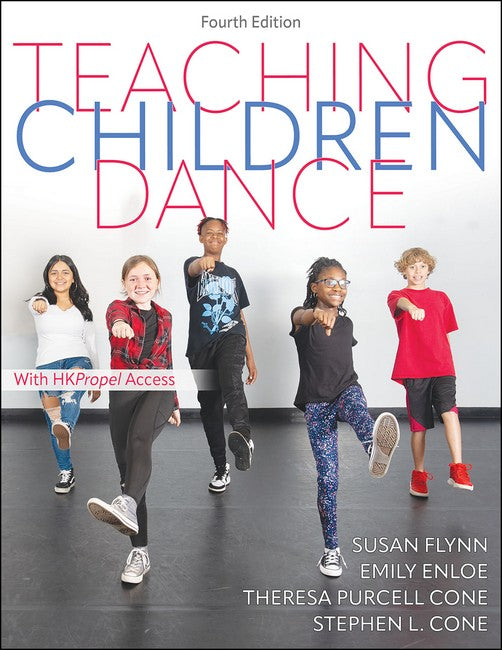Susan Flynn, MA, teaches in the School of Education, Health, and Human Performance at the College of Charleston, South Carolina, training students in sport pedagogy and preK-5 teacher education. Flynn specializes in the areas of rhythms and dance in the PE curriculum, adapted physical education, and elementary methods. She has also taught at Purdue University and in public schools in Maryland. Flynn developed the Perceptual Motor Development Clinic at the University of Toledo and was director for 10 years. She also organized Petes Pals, a mentoring initiative at Purdue University offering aquatic and motor therapy for children with disabilities. Currently, she conducts a similar program at the College of Charleston called FitCatZ Aquatic and Motor Therapy. Emily Enloe, EdD, is a dance educator at Oakbrook Middle School in Charleston, South Carolina. In addition to teaching, Enloe was the graduate mentor for the Dancers Connect program housed through the University of South Carolinas dance education program from August 2010 to May 2014. Work with this program earned Enloe the 2012 Elsa Posey Graduate Student Scholarship from the National Dance Education Organization. She earned her MEd in early childhood education from the University of South Carolina in August 2013, and she continues to present at workshops and both state and national conferences in addition to teaching. Dr. Enloe is past president of the South Carolina Alliance for Health, Physical Education, Recreation and Dance as well as the South Carolina Dance Association. She graduated from Charleston Southern University with an EdD in leadership in May 2022. Stephen L. Cone, PhD, is a professor emeritus in the department of health and exercise science at Rowan University in New Jersey. Dr. Cone is past president of the American Alliance for Health, Physical Education, Recreation and Dance (AAHPERD; now SHAPE America) and received their Honor Award in 2000. He is also a member of the New Jersey AHPERD, the Alliance for Arts Education New Jersey, and numerous other professional organizations. He has written dozens of articles for physical education publications and was coauthor of Interdisciplinary Teaching Through Physical Education (Human Kinetics, 1998) and the three previous editions of Teaching Children Dance. Theresa Purcell Cone, PhD (1950-2019), was a physical education and dance teacher at Brunswick Acres Elementary School in Kendall Park, New Jersey, where she also directed a childrens dance company. She was an adjunct professor at Rowan University in New Jersey and a teacher and choreographer at the Princeton Ballet School. Dr. Cone was a past president of the National Dance Association and was named its first Dance Educator of the Year. She was also a member of the National Dance Education Organization, the Alliance for Arts Education New Jersey, and numerous other professional organizations. Dr. Cone was coauthor of Interdisciplinary Teaching Through Physical Education (Human Kinetics, 1998). In 2004, Dr. Cone was awarded a Presidential Citation by the American Alliance for Health, Physical Education, Recreation and Dance. She also was awarded the Margie R. Hanson Distinguished Service Award by the National Association for Sport and Physical Education. Dr. Cone received her doctorate in dance from Temple University.
Request Academic Copy
Please copy the ISBN for submitting review copy form
Description
Part I. A Framework for Teaching Childrens Dance Chapter 1. Understanding the Importance of Teaching Childrens Dance What Is Childrens Dance? Why Teach Childrens Dance? What Are the Benefits of Childrens Dance? Applying 21st-Century Skills to Teaching Dance Meeting the Whole Child Through Dance Linking the Physical Activity Guidelines to Dance Summary Questions for Reflection Chapter 2. Presenting Essential Content for Childrens Dance The Body Body Shapes Space Time Force Flow Relationships Dance Forms Summary Questions for Reflection Chapter 3. Designing a Dance Program Planning a Yearlong Dance Program Planning a Dance Unit Planning the Dance Lessons Sample Unit and Lesson Outline Interdisciplinary Connections Summary Questions for Reflection Chapter 4. Creating a Dance Education Setting Class Size Equipment and Teaching Materials Facilities Class Frequency and Length Community Characteristics School Policies Program Advocacy Summary Questions for Reflection Chapter 5. Making Teaching Effective Helping All Students Learn Using Various Teaching Styles and Strategies Motivating Learners Establishing Protocols and Rules Creating a Safe Learning Environment Presenting Demonstrations Providing Feedback Engaging Students in Performances Observing and Responding to Dance Summary Questions for Reflection Chapter 6. Assessing Childrens Learning in Dance Teacher Assessment of Program Teacher Assessment of Students Peer Assessment Student Self-Assessment Assessment Instruments Summary Questions for Reflection Chapter 7. Including All Children in Dance Knowing Your Students With Disabilities Creating an Inclusive Environment Implementing Inclusive Teaching Strategies Inclusive Dances Summary Questions for Reflection Part II. Learning Experiences Chapter 8. Learning Experiences for Kindergarten, First Grade, and Second Grade Neighborhood Friendship Streamer Dance Floating Clouds and Rain Showers Run, Hop, Jump, Skip The Playground Ocean Waves and Swimmers Spaghetti Dance Balloon Dance Percussion Instrument Dance The Hungry Cat Circus Dance Connect the Spots Frog Dance Chapter 9. Learning Experiences for Third Through Eighth Grades Dancing Homework Machine Creative Square Dance Action Words Baseball Dance Birthday Celebration Partner Dance Three Sport Dances: Sport Add-On, Sport Web, and Sport Pictures in Action Dance Maps Create Your Own Hip-Hop Dance Funky Shape Museum Stick Figures Come Alive Chapter 10. Learning Experiences in Popular, Fitness, and Social Dances Overview of Popular, Fitness, and Social Dances Teaching Strategies for Choreographed Dance Lessons Basic Social and Popular Dance Movements Learning Experiences 5, 6, 7, 8 Steps Line Dance 16-Step Contra Dance Disco Fever Dance Funky Cowboy Line Dance Grapevine Slide Dance Hey Baby Line Dance The Hit Man Contra Dance Honky Tonk Line Dance Honky Tonk Circle Dance Rockin Shuffle Rock This Party Line Dance Baba Hou Fitness Dance T Fitness Dance Cha-Cha Plank Fitness Dance Circle Jam Fitness Dance Tabata Dance Salsa Swing Cha-Cha Create Your Own Fitness Dance Create Your Own Popular Dance Sample Rubrics Chapter 11. Learning Experiences in Folk and Cultural Dances American Square Dance Bele Kawe Appalachian Big Circle (Elementary Version) Appalachian Big Circle (Secondary Version) Kinderpolka La Raspa Mayim, Mayim Samoan Sasa Tanko Bushi Tinikling Virginia Reel

